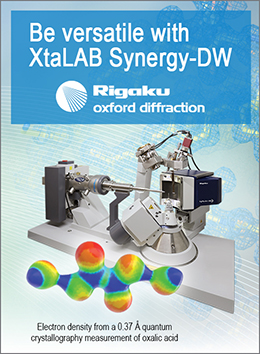


Editorial
Lasting legacies
![Tilting perovskite [Tilting perovskite]](https://www.iucr.org/__data/assets/image/0004/142375/Editorial_resized.gif)
It is with considerable sadness that I have to announce that, since the last issue of the Newsletter, the crystallography community has lost yet another of its most distinguished members, Joel Bernstein. He was an entertaining speaker and was the world’s leading expert on the subject of polymorphism. I knew him well as a personal friend, and I mourn his passing. You can read his obituary in this issue of the Newsletter, together with those of Tom Steitz, Aaron Klug and Håkon Hope.
Following my article on quartz in the last issue, I was pleased to receive several comments by email and so we decided to publish an article by Shigeru Ohba, showing how to use the so-called Airy’s spiral to determine the hand of a quartz crystal. It seems that one can talk endlessly about quartz. We also publish comments by Wulf Depmeier on the interesting ideas proposed by JuanMa García-Ruiz on the effect of the observation of crystals, such as quartz, on the development of ancient hominid brains. Wulf suggests that these early humans were probably attracted initially by the high reflectivity of crystals.
We also have a couple of interesting articles on the history of crystallography. Some time ago, while I was looking through my old files, I discovered a printed copy of Max von Laue’s address to the 1st Congress of the International Union of Crystallography in 1948. In it, Max described the early work in 1912 that led to the discovery of X-ray diffraction and includes an amusing account of how their electrical apparatus caused the lights in the university to buzz! This nearly got them into trouble. The second article is on the life and scientific works of Auguste Bravais in the mid-19th century. Although I knew about his work on the theory of lattices (we all know of the 14 Bravais lattice types, don’t we?), I had not realized before just what a formidable polymath he was. Well worth reading!
The IUCr awards at each of its international congresses a prestigious prize, the Ewald Prize, to an established crystallographer of distinction. During the Hyderabad Congress, it was suggested that we should set up another prize, this time in honour of W. H. and W. L. Bragg, to be awarded to one or two early-career researchers. The first such award(s) will be made at the next Congress in Prague in 2020. A special committee under the chair of Elena Boldyreva has been set up tasked with choosing one or two promising early-career scientists. You can help in getting this award established by nominating candidates to the IUCr Executive Secretary.
Another important contribution in this issue is by Gervais Chapuis and Carol Brock on the IUCr Online Dictionary of Crystallography. As they explain, this is set up as a wiki to enable anyone to contribute definitions of crystallography-related terms. If you need to find a definition this is one of the first places to go.
Finally, in this issue we have an important opinion piece by Massimo Nespolo on the growing problem of so-called predatory journals. Massimo is well known for not pulling his punches! I am sure that most of us have received emails inviting us to publish papers, or to become a member of the editorial board/reviewing team and so on. I get roughly two of these per day. As explained by Massimo, you need to be aware of this and how to spot them. There are so many journals being advertised these days it is sometimes difficult to know which are reputable and which, to put it simply, are just money-making scams.
There is another type of scam that we need to watch out for, namely “predatory conferences”. Again, I must receive at least two email invitations to these every day. They often have grandiose titles including the words “World” or “International” or “Advanced” and seem to be sent by representatives of commercial companies, often adopting a (possibly fake) female name (I assume this is intended to attract my attention). Often the venue is simply the name of a city, but no mention of the actual location within the city. I recall one of them had a photograph of the University Museum in Oxford, referring it to as being in London! One that I received recently had on its website a list of “Major Associations around the Globe” which included the IUCr! This is obviously a cynical attempt at trying to lend an air of respectability to their conference. The email that I received said “the conference is going to get you inspired beyond your wits and head to a new destination to encounter your creative circuit”! Not sure what that means, and whether at my age I still have any creative circuits! Moreover, you have only to look at the names of the organizers on their websites to see that most of them refer to minor figures. Often the standard of English is very poor, and even more importantly displays a complete lack of knowledge of the science. Here, for your amusement, is an example from the website of one such recent conference announcement on crystallography:
Chemical Crystallography is a use of diffraction methods to the investigation of basic science. An incessant reason for existing is the recognizable proof of common items, or of the results of manufactured science tests; however point by point sub-atomic geometry, intermolecular collaborations and supreme designs can likewise be considered. Structures can be examined as an element of temperature, weight or the utilization of electromagnetic radiation, or attractive or electric field: such studies involves just little minority of the aggregate. The utilization of single precious stone X-beam diffraction to decide the structure of a concoction compound has been generally delegated 'Substance Crystallography'. The strategies, the exactness in analyses combined with the modem PC contraptions and advances in innovation makes this branch of science an unequivocal supplier of precise and exact estimations of sub-atomic measurements. Structure assurance by powder diffraction, precious stone designing, charge thickness examination and studies on atoms in energized states are the late additional items.
What? Unfortunately, and this is serious, I have heard of cases where people have been led into paying money to attend these types of “conference”. You can find many websites on the internet that discuss this problem: just search the web for “Predatory conferences”. You have been warned!
Finally, Massimo Nespolo and I have been on the warpath regarding publications in which the terms ‘lattice’ and ‘structure’ (and corresponding ‘superlattice’ and ‘superstructure’) appear to be incorrectly used interchangeably. You can read Massimo’s latest paper on this here. This should be required reading by all crystallographers (anyone in fact discussing crystal structures).
Copyright © - All Rights Reserved - International Union of Crystallography







